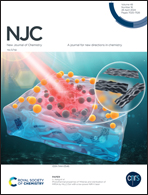Tannic acid induced in situ growth of an underwater superoleophobic ZIF-8 composite membrane for emulsion separation
Abstract
The potential of bionic-inspired superhydrophobic membranes in the field of oil–water separation is significant. In this study, tannic acid induced the rhombohedral crystal form of ZIF-8 to grow in situ on a nylon membrane, resulting in the formation of a layered micro-nano structure. As a result, we successfully prepared a multifunctional composite membrane with exceptional underwater superoleophobicity and oil anti-adhesion. The composite membrane demonstrated an impressive separation flux for layered oil–water mixtures, reaching up to 4851.2 L m−2 h−1. Furthermore, when dealing with surfactant-free oil-in-water emulsions, the separation efficiency exceeded 99.0%. Because ZIF-8 is positively charged, the composite membrane exhibits different separation fluxes in the presence of different surfactants. For SDS stabilized toluene emulsion in water, the maximum separation flux of the composite membrane is 1307.4 L m−2 h−1. The membrane also has good tolerance to alkali and salt substances and is easy to recycle and reuse. Consequently, the ZIF-8 composite membrane has significant potential in effectively separating oil–water emulsions.



 Please wait while we load your content...
Please wait while we load your content...